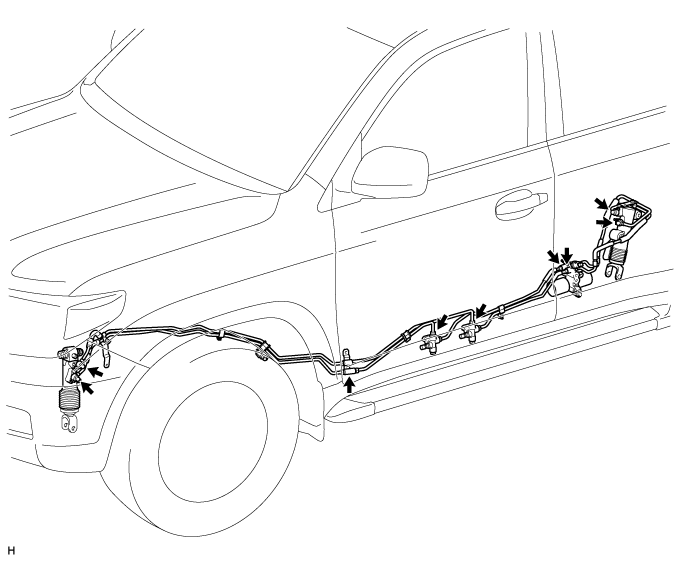Land Cruiser URJ200 URJ202 GRJ200 VDJ200 - SUSPENSION CONTROL
SUSPENSION CONTROL SYSTEM (w/ KDSS) - ON-VEHICLE INSPECTION
| 1. MEASURE VEHICLE HEIGHT |
- NOTICE:
- HINT:
Set the tire pressure to the specified value(s) ().
Bounce the vehicle to stabilize the suspension.

Measure the distance from the ground to the top of the bumper and calculate the difference in the vehicle height between left and right. Perform this procedure for both the front and rear wheels.
- Height difference of left and right sides:
- 15 mm (0.591 in.) or less
- HINT:
- If not as specified, perform the vehicle tilt calibration.
| 2. VEHICLE TILT CALIBRATION |
- NOTICE:
- HINT:
Remove the stabilizer control valve protector ().
Using a 5 mm socket hexagon wrench, loosen the lower and upper chamber shutter valves of the stabilizer control with accumulator housing 2.0 to 3.5 turns.

- NOTICE:
- HINT:
- By loosening the shutter valves, the upper and lower chamber will be fully connected, and the vehicle height is corrected by the equalization of the upper and lower chamber oil pressure.
Bounce the vehicle to stabilize the suspension.
Check the difference in height between the left and right sides of the vehicle. Refer to Measure Vehicle Height.
- HINT:
- When the vehicle height of the left and right side of the vehicle is not within the specified range, bleed the air ().
Using a 5 mm socket hexagon wrench, tighten the lower and upper chamber shutter valves of the stabilizer control with accumulator housing.
- Torque:
- 14 N*m{ 143 kgf*cm, 10 ft.*lbf}
Install the stabilizer control valve protector ().
| 3. INSPECT FOR SUSPENSION FLUID LEAK |
- CAUTION:
- Fluid is pumped into the system at a high pressure of approximately 3 MPa (30.6 kgf/cm2, 435 psi). If a fluid leak is discovered, immediately release the pressure and repair the fluid leak.
Perform a driving test.
Check for fluid leakage from the parts and connections.
